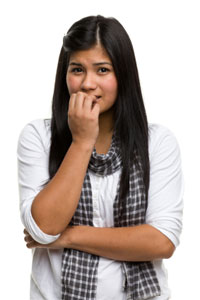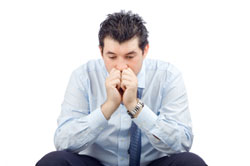|
ANXIETY IN CHILDREN AND ADULTS
 Children and adolescents all experience anxiety. Anxiety in children is expected and normal at particular times in development. For example, from approximately age 8 months through the preschool years, healthy children may show intense distress (anxiety) at times of separation from their mothers or other persons with whom they are close. Young children may have short-lived fears, (such as fear of the dark, storms, animals, or strangers). Anxious children are often overly tense or uptight. Some may need a lot of reassurance, and their worries may interfere with activities. Parents should not discount a child’s fears. Because anxious children may also be quiet, compliant and eager to please, their difficulties may be missed. Parents should be alert to the signs of severe anxiety so they can intervene early to prevent complications. There are different types of anxiety in children. Children and adolescents all experience anxiety. Anxiety in children is expected and normal at particular times in development. For example, from approximately age 8 months through the preschool years, healthy children may show intense distress (anxiety) at times of separation from their mothers or other persons with whom they are close. Young children may have short-lived fears, (such as fear of the dark, storms, animals, or strangers). Anxious children are often overly tense or uptight. Some may need a lot of reassurance, and their worries may interfere with activities. Parents should not discount a child’s fears. Because anxious children may also be quiet, compliant and eager to please, their difficulties may be missed. Parents should be alert to the signs of severe anxiety so they can intervene early to prevent complications. There are different types of anxiety in children.
Symptoms of separation anxiety include:
- constant thoughts and intense fears about the safety of parents and caretakers
- refusing to go to school
- frequent stomachaches and other physical complaints
- extreme worries about sleeping away from home
- being overly clingy
- panic or tantrums at times of separation from parents
- trouble sleeping or nightmares
Symptoms of phobia include:
- extreme fear about a specific thing or situation (ex. dogs, insects, or needles)
- the fears cause significant distress and interfere with usual activities
Symptoms of social anxiety include:
- fears of meeting or talking to people
- avoidance of social situations
- few friends outside the family
Other symptoms of anxious children include:
- many worries about things before they happen
- constant worries or concerns about family, school, friends, or activities
- repetitive, unwanted thoughts (obsessions) or actions (compulsions)
- fears of embarrassment or making mistakes
- low self esteem and lack of self-confidence
Severe anxiety problems in children can be treated. Early treatment can prevent future difficulties, such as loss of friendships, failure to reach social and academic potential, and feelings of low self-esteem. Treatments may include a combination of the following: individual psychotherapy, family therapy, medications, behavioral treatments, and consultation to the school.
If anxieties become severe and begin to interfere with the child’s usual activities, (for example separating from parents, attending school and making friends) parents should consider seeking an evaluation from a qualified mental health professional or a child and adolescent psychiatrist.
Anxiety in Adults
 Anxiety is a general term for several disorders that cause nervousness, fear, apprehension, and worrying. These disorders affect how we feel and behave, and they can manifest real physical symptoms. Mild anxiety is vague and unsettling, while severe anxiety can be extremely debilitating, having a serious impact on daily Anxiety is a general term for several disorders that cause nervousness, fear, apprehension, and worrying. These disorders affect how we feel and behave, and they can manifest real physical symptoms. Mild anxiety is vague and unsettling, while severe anxiety can be extremely debilitating, having a serious impact on daily
People often experience a general state of worry or fear before confronting something challenging such as a test, examination, recital, or interview. These feelings are easily justified and considered normal. Anxiety is considered a problem when symptoms interfere with a person's ability to sleep or otherwise function. Generally speaking, anxiety occurs when a reaction is out of proportion with what might be normally expected in a situation.
Anxiety disorders can be classified into several more specific types. The most common are briefly described below.
What is Generalized Anxiety Disorder (GAD)?
Generalized Anxiety Disorder (GAD) is a chronic disorder characterized by excessive, long-lasting anxiety and worry about nonspecific life events, objects, and situations. GAD sufferers often feel afraid and worry about health, money, family, work, or school, but they have trouble both identifying the specific fear and controlling the worries. Their fear is usually unrealistic or out of proportion with what may be expected in their situation. Sufferers expect failure and disaster to the point that it
What is Panic Disorder?
Panic Disorder is a type of anxiety characterized by brief or sudden attacks of intense terror and apprehension that leads to shaking, confusion, dizziness, nausea, and difficulty breathing. Panic attacks tend to arise abruptly and peak after 10 minutes, but they then may last for hours. Panic disorders usually occur after frightening experiences or prolonged stress, but they can be spontaneous as well. A panic attack may lead an individual to be acutely aware of any change in normal body function, interpreting it as a life threatening illness - hypervigiliance followed by hypochondriasis. In addition, panic attacks lead a sufferer to expect future attacks, which may cause drastic behavioral changes in order to avoid these attacks.
People often experience a general state of worry or fear before confronting something challenging such as a test, examination, recital, or interview. These feelings are easily justified and considered normal. Anxiety is considered a problem when symptoms interfere with a person's ability to sleep or otherwise function. Generally speaking, anxiety occurs when a reaction is out of proportion with what might be normally expected in a situation.
Anxiety disorders can be classified into several more specific types. The most common are briefly described below.
What is a Phobia?
A Phobia is an irrational fear and avoidance of an object or situation. Phobias are different from generalized anxiety disorders because a phobia has a fear response identified with a specific cause. The fear may be acknowledged as irrational or unnecessary, but the person is still unable to control the anxiety that results. Stimuli for phobia may be as varied as situations, animals, or everyday objects. For example, agoraphobia occurs when one avoids a place or situation to avoid an anxiety or panic attack. Agoraphobics will situate themselves so that escape will not be difficult or embarrassing, and they will change their behavior to reduce anxiety about being able to escape.
What is Social Anxiety Disorder?
Social Anxiety Disorder is a type of social phobia characterized by a fear of being negatively judged by others or a fear of public embarrassment due to impulsive actions. This includes feelings such as stage fright, a fear of intimacy, and a fear of humiliation. This disorder can cause people to
What is Obsessive-Compulsive Disorder (OCD)?
Obsessive-Compulsive Disorder (OCD) is an anxiety disorder characterized by thoughts or actions that are repetitive, distressing, and intrusive. OCD suffers usually know that their compulsions are unreasonable or irrational, but they serve to alleviate their anxiety. Often, the logic of someone with OCD will appear superstitious, such as an insistence in walking in a certain pattern. OCD sufferers may obsessively clean personal items or hands or constantly check locks, stoves, or light switches.
What is Post-Traumatic Stress Disorder (PTSD)?
Post-traumatic Stress Disorder (PTSD) is anxiety that results from previous trauma such as military combat, rape, hostage situations, or a serious accident. PTSD often leads to flashbacks and behavioral changes in order to avoid certain stimuli.
Dr. Rudominer and his staff are experienced in the proper diagnosis and treatment of anxiety disorders.
|



